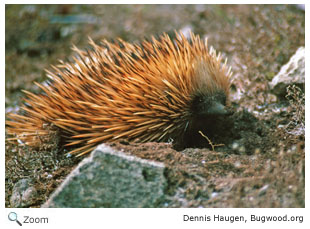Female monotremes lay eggs. They carry small, leathery eggs in a pouch, and the babies hatch from the eggs. After the babies hatch, they receive milk from their mother, just like other mammals, but the milk doesn't come from a teat. Female monotremes secrete milk onto the surface of their skin. It's as if the female is "sweating" milk. The milk sticks to the hair and skin of the mother, and the babies lick it off. Adult monotremes have no teeth and male monotremes have spurs on their ankles that they probably use to defend themselves from predators. Monotremes have a single opening or cloaca that serves as a passageway for urine and fecal waste and as a reproductive tract. There are two families in this order, Ornithorhynchidae and Tachyglossidae. There are only three species of monotremes, the duck-billed platypus and two species of echidnas, or spiny anteaters.
|
||||||||||

